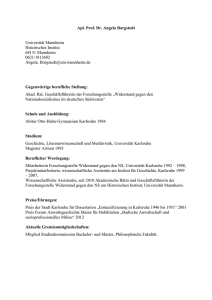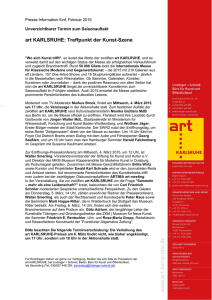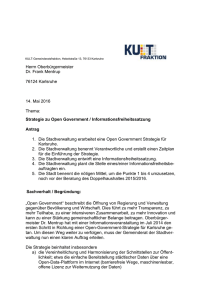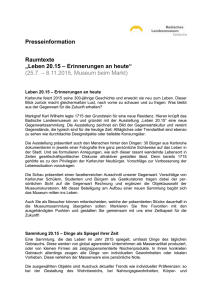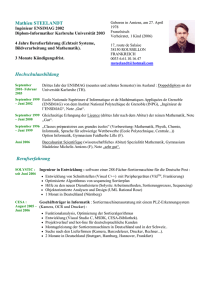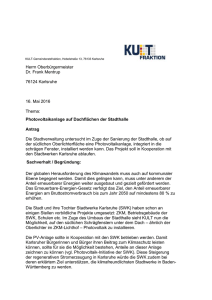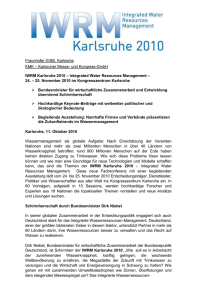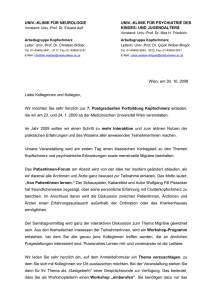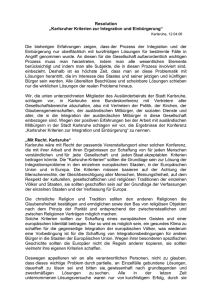Document
Werbung
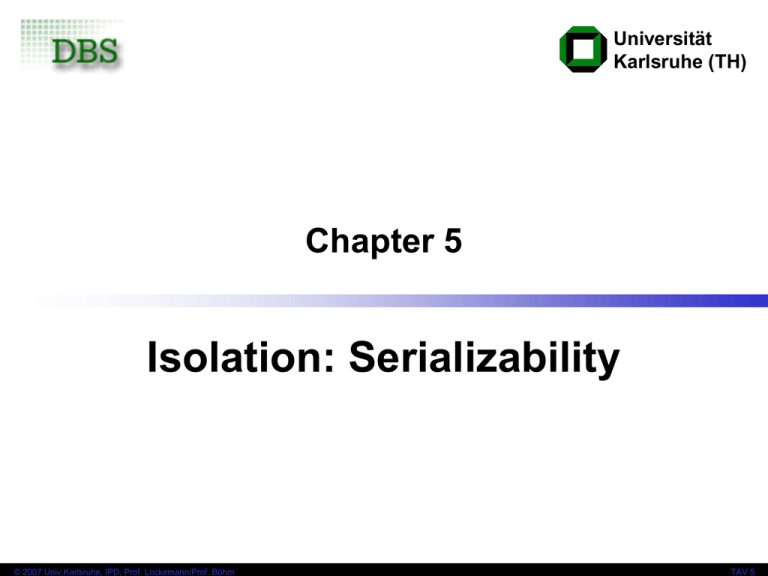
Universität
Karlsruhe (TH)
Chapter 5
Isolation: Serializability
© 2007 Univ,Karlsruhe, IPD, Prof. Lockemann/Prof. Böhm
TAV 5
Agenda
‹#›
Conflict serializability
Order preservation
View serializability
Final-state serializability
Commit serializability
© 2007 Univ,Karlsruhe, IPD, Prof. Lockemann/Prof. Böhm
TAV 5
‹#›
Conflict serializability
© 2007 Univ,Karlsruhe, IPD, Prof. Lockemann/Prof. Böhm
TAV 5
Conflict equivalence
‹#›
Remember: We study histories, and we ignore aborted
transactions.
Definition 5.1 (Conflict equivalence)
(Def. 4.23 specialized)
Two histories h und h' are conflict equivalent (h C h')
op(h) = op(h')
conf(h) = conf(h')
© 2007 Univ,Karlsruhe, IPD, Prof. Lockemann/Prof. Böhm
TAV 5
Conflict equivalence
‹#›
Example 5.2 Histories over two transactions:
h2
w1(y)
r1(x)
r1(y)
w1(x)
c1
r2(z)
w2(y)
w2(x)
h3 r1(x)
r1(y)
c2
w1(x)
w1(y)
r2(z)
c1
w2(y)
w2(x)
h4
c2
w1(x)
r1(x)
r1(y)
r2(z)
w2(x)
© 2007 Univ,Karlsruhe, IPD, Prof. Lockemann/Prof. Böhm
c1
w1(y)
w2(y)
c2
r1(x)
r1(y)
h2 h3
h4
h2
r2(z)
h4 h3
w1(x)
w1(y)
w2(y)
c1
c2
w2(x)
TAV 5
Conflict serializability
‹#›
Definition 5.3
Conflict serializability: A history h is conflict serializable if
there exists a conflict equivalent serial history hs: hs serial:
CP(h) C hs
A schedule s is conflict serializable if there exists a serial
history hs s.t. hs serial: CP(s) C hs
Corollary 5.4
A history h is conflict serializable if
Remember: conf(s)
hs serial: CP(h) C hs conf(h) = conf(hs). ignores aborted
transactions
Definition 5.5
CSR ::= Set of all conflict serializable histories.
© 2007 Univ,Karlsruhe, IPD, Prof. Lockemann/Prof. Böhm
TAV 5
Proving conflict serializability
‹#›
Idea: Find a good characterization for conf(hs). Then, for h
serializable the same characterization should hold for
conf(h).
Needed: Efficient proof procedure.
Standard approach: Try a graph.
© 2007 Univ,Karlsruhe, IPD, Prof. Lockemann/Prof. Böhm
TAV 5
Conflict graph
‹#›
Definition 5.6 (Conflict Graph):
Let h be a history. The conflict graph G(h) = (V, E) is a directed
graph with
vertices V := commit(h)
and
edges E := {(t, t‘) | t t‘
and there are operations p t, q t‘ with (p, q) conf(h)}.
h2
w1(y)
r1(x)
r1(y)
w1(x)
w2(x)
G(h2) = t1
© 2007 Univ,Karlsruhe, IPD, Prof. Lockemann/Prof. Böhm
c1
r2(z)
w2(y)
c2
t2
TAV 5
Conflict graph
‹#›
Definition 5.6 (Conflict Graph):
Let h be a history. The conflict graph G(h) = (V, E) is a directed
graph with
vertices V := commit(s)
and
edges E := {(t, t‘) | t t‘
and there are operations p t, q t‘ with (p, q) conf(h)}.
An edge t t‘ indicates that at least one operation in t
precedes an operation in t‘ and the two are in conflict.
In a serial history: All operations in t precede those in t‘.
G(hs), hs serial, is acyclic.
Failure if G(h) contains a cycle.
© 2007 Univ,Karlsruhe, IPD, Prof. Lockemann/Prof. Böhm
TAV 5
Correctness proof
‹#›
From intuition to proof:
Theorem 5.7:
Let h be a history. Then h CSR G(h ) is acyclic.
© 2007 Univ,Karlsruhe, IPD, Prof. Lockemann/Prof. Böhm
TAV 5
Correctness proof
(i)
h CSR G(h ) is acyclic
Let h be a history in CSR. So there is a serial history h‘ with conf(h) = conf(h‘).
Now assume that G(h) has a cycle t1 t2 ... tk t1.
This implies that there are pairs (p1, q2), (p2, q3), ... , (pk, q1)
with pi ti, qi ti, pi <h q(i+1), and pi in conflict with q(i+1).
Because h‘C h, it also implies that pi <h‘ q(i+1).
Because h‘ is serial, we obtain ti <h‘ t(i+1) for i=1, ..., k-1, and tk <h‘ t1.
By transitivity we infer t1 <h‘ t2 and t2 <h‘ t1, which is impossible.
The initial assumption is wrong. So G(h) is acyclic.
‹#›
(ii) h CSR G(h ) is acyclic
Let G(h) be acyclic. So it must have at least one source node.
The following topological sort produces a total order < of transactions:
a) start with a source node (i.e., a node without incoming edges),
b) remove this node and all its outgoing edges,
c) iterate a) and b) until all nodes have been added to the sorted list.
The total transaction ordering order < preserves the edges in G(h);
therefore it yields a serial schedule h‘ for which h‘C h.
© 2007 Univ,Karlsruhe, IPD, Prof. Lockemann/Prof. Böhm
TAV 5
Efficient correctness proof
‹#›
From proof (ii) we conclude that if for a history h, G(h)
is acyclic, h is equivalent to every serial history that is a
topological order of G(h).
Since in general there are several such orders, there
may be several serial histories that are equivalent to h.
Conflict serializability can be computed in polynomial
time – in fact in square time because of the simple test
on acyclicity.
© 2007 Univ,Karlsruhe, IPD, Prof. Lockemann/Prof. Böhm
TAV 5
Efficient correctness proof: Illustration
‹#›
Example 5.8: Take earlier history that was view
serializable but not conflict serializable:
r1(h) r2(a) r1(f) r2(e) w2(h) r3(a) r1(i) r1(d) w1(d) w1(f) r1(b)
r2(g) w1(h) r2(d) w1(c) w2(c) r1(e) w1(i) c1 w3(h) c2 c3.
data
elements
Legend:
i
h
g
f
e
d
Read by t1
Write by t1
Read by t2
Write by t2
Read by t3
Write by t3
c
b
a
time
© 2007 Univ,Karlsruhe, IPD, Prof. Lockemann/Prof. Böhm
TAV 5
Efficient correctness proof: Illustration
‹#›
Example 5.8 cont’d: Conflict graph:
t2
t1
data
elements
t3
Legend:
i
h
g
f
e
d
Read by t1
Write by t1
Read by t2
Write by t2
Read by t3
Write by t3
c
b
a
time
© 2007 Univ,Karlsruhe, IPD, Prof. Lockemann/Prof. Böhm
TAV 5
Efficient correctness proof: Illustration
‹#›
Example 5.9: Histories in the booking example:
h1: r1(B) r2(B) r2(T) w2(T) w2(B) c2 r1(T) c1
h2: r2(B) r2(T) r1(B) r1(T) c1 w2(T) w2(B) c2
h3: r2(B) r2(T) w2(T) r1(B) r1(T) c1 w2(B) c2
h4: r2(B) r2(T) w2(T) w2(B) r1(B) r1(T) a2 c1
only t1 to consider!
h5: r3(T) w3(T) r2(B) r2(T) w2(T) w2(B) c2 r3(B) w3(B) c3
h6: r2(B) r2(T) r3(T) w3(T) r3(B) w3(B) c3 w2(T) w2(B) c2
h1: t1
t2
h2: t1
© 2007 Univ,Karlsruhe, IPD, Prof. Lockemann/Prof. Böhm
t2
h3: t1
t2
h5: t2
t3
h6: t2
t3
TAV 5
Efficient correctness proof: Illustration
‹#›
Example 5.10:
r3(x)
w3(x)
c1
h5 = r1(x)
w1(x)
w1(y)
r2(x)
w2(y)
c2
t1
t3
G(h5) = t2
c3
Equivalent serial history: t2,t1,t3
© 2007 Univ,Karlsruhe, IPD, Prof. Lockemann/Prof. Böhm
TAV 5
Efficient correctness proof: Illustration
‹#›
Example 5.10 modified:
r3(x)
z
w3(x)
/
c1
h5 = r1(x)
w1(x)
w1(y)
r2(x)
w2(y)
c2
c3
X
G(h5) = t2
t1
t3
Equivalent serial history: t2,t1,t3
Note: In general ti tj , tj tk ti tk.
© 2007 Univ,Karlsruhe, IPD, Prof. Lockemann/Prof. Böhm
TAV 5
Efficient correctness proof: Illustration
‹#›
Example 5.11:
h6 = w1(x) w1(y) c1 r2(x) r3(y) w2(x) c2 w3(y) c3
G(h6) = t1
t2
t3
Equivalent serial histories:
t1,t2,t3
t1,t3,t2
© 2007 Univ,Karlsruhe, IPD, Prof. Lockemann/Prof. Böhm
TAV 5
Serialization by reordering
‹#›
Remember our examples with serialization by reordering
of operations. Is there a relationship between CSR and
reordering? Formalize:
Commutativity rules:
C1: ri(x) rj(y) ~ rj(y) ri(x) if i j
C2: ri(x) wj(y) ~ wj(y) ri(x) if ij and xy
C3: wi(x) wj(y) ~ wj(y) wi(x) if ij and xy
Ordering rule:
C4: oi(x), pj(y) unordered ~ oi(x) pj(y)
if xy or both o and p are reads
© Weikum, Vossen, 2002
© 2007 Univ,Karlsruhe, IPD, Prof. Lockemann/Prof. Böhm
TAV 5
Serialization by reordering
‹#›
Commutativity rules:
C1: ri(x) rj(y) ~ rj(y) ri(x) if i j
C2: ri(x) wj(y) ~ wj(y) ri(x) if ij and xy
C3: wi(x) wj(y) ~ wj(y) wi(x) if ij and xy
Ordering rule:
C4: oi(x), pj(y) unordered ~ oi(x) pj(y)
if xy or both o and p are reads
Example for transformations of schedules:
s
= w1(x) r2(x) w1(y) w1(z) r3(z) w2(y) w3(y) w3(z)
~ (C2)
w1(x) w1(y) r2(x) w1(z) w2(y) r3(z) w3(y) w3(z) r2(x) and r3(z)
can be delayed
~ (C2)
w1(x) w1(y) w1(z) r2(x) w2(y) r3(z) w3(y) w3(z)
= t1 t2 t3
© Weikum, Vossen, 2002
© 2007 Univ,Karlsruhe, IPD, Prof. Lockemann/Prof. Böhm
TAV 5
Commutativity-based reducibility
‹#›
Definition 5.12 (Commutativity Based Equivalence):
Schedules s and s‘ s.t. op(s)=op(s‘) are commutativity based equivalent,
denoted s ~* s‘, if s can be transformed into s‘ by applying rules
C1, C2, C3, C4 finitely many times.
Theorem 5.13:
Let s and s‘ be schedules s.t. op(s)=op(s‘). Then s c s‘ iff s ~* s‘.
Definition 5.14 (Commutativity Based Reducibility):
Schedule s is commutativity-based reducible if there is a serial schedule s‘
s.t. s ~* s‘.
Corollary 5.15:
Schedule s is commutativity-based reducible iff s CSR.
© Weikum, Vossen, 2002
© 2007 Univ,Karlsruhe, IPD, Prof. Lockemann/Prof. Böhm
TAV 5
Commutativity-based reducibility
‹#›
Practical value?
Scheduler may control the sequence of operations
solely based on observing/recognizing conflicts
Just tell the scheduler which conflicts can occur
It does not need to know any further operator details
© 2007 Univ,Karlsruhe, IPD, Prof. Lockemann/Prof. Böhm
TAV 5
‹#›
Order preservation
© 2007 Univ,Karlsruhe, IPD, Prof. Lockemann/Prof. Böhm
TAV 5
Order preserving conflict serializability
‹#›
Example 5.16
Take history
h = w1(x) r2(x) c2 w3(y) c3 w1(y) c1
G(h) = t3
t1
t2
Unpleasant because t2 was committed by the
time t3 starts.
Imagine we keep a chronological record of the transactions
and for some reason would have to redo the transactions!
© 2007 Univ,Karlsruhe, IPD, Prof. Lockemann/Prof. Böhm
TAV 5
Order preserving conflict serializability
‹#›
Definition 5.17
History h (or the committed projection h=CP(s) of schedule
s) is order preserving conflict serializable if h is conflict
equivalent to a serial history hs where
t,t' h:
if t occurs completely before t' in h
then the same holds in hs
Definition 5.18
OCSR ::= Set of all order preserving conflict serializable
histories.
In OCSR histories, transactions cannot commute if they
do not overlap in time
© 2007 Univ,Karlsruhe, IPD, Prof. Lockemann/Prof. Böhm
TAV 5
Order preserving conflict serializability
‹#›
Corollary 5.19
OCSR CSR
by Def. 5.17. See example 5.16 for proper inclusion :
G(h) OCSR, because t3 t1 t2 does not preserve the
order of the non-overlapping transactions t2, t3.
© 2007 Univ,Karlsruhe, IPD, Prof. Lockemann/Prof. Böhm
TAV 5
Commit-Order Preservation (1)
‹#›
Definition 5.20 (Commit-Order Preservation )
History h is commit-ordered if:
ti,tj h, i j, p opi , q opj: (p,q) conf(h) ci <h cj
Definition 5.21
COCSR ::= Set of all commit-ordered histories.
The order of two operations that are in conflict agrees with
the order of the commit operations of their respective
transactions.
© 2007 Univ,Karlsruhe, IPD, Prof. Lockemann/Prof. Böhm
TAV 5
Commit-Order Preservation (2)
‹#›
Theorem 5.22
COCSR CSR
Proof:
Let h COCSR und (ti,tj) G(h).
(definition COCSR ) ci <h cj.
By induction: for all paths (t1,…,tn) G(h):
ci <h ci+1 for 1 i < n.
COCSR CSR: Let hCSR G(h) cyclic. Let (t1,…,tn,t1) be
a cycle. c1 <h c1 (contradiction).
CSR COCSR: h = r1(x) w2(x) c2 c1 is CSR but not COCSR.
© 2007 Univ,Karlsruhe, IPD, Prof. Lockemann/Prof. Böhm
TAV 5
Commit-Order Preservation (3)
‹#›
Theorem 5.23
COCSR OCSR
Example 5.24
h1 = w1(x) r2(x) c2 w3(y) c3 w1(y) c1
CSR, not OCSR, COCSR
h2 = w3(y) c3 w1(x) r2(x) c2 w1(y) c1
OCSR, not COCSR
h3 = w3(y) c3 w1(x) r2(x) w1(y) c1 c2
COCSR
G(h) = t3
© 2007 Univ,Karlsruhe, IPD, Prof. Lockemann/Prof. Böhm
t1
t2
TAV 5
CSR restrictions
‹#›
Summary
CSR
OCSR
COCSR
© 2007 Univ,Karlsruhe, IPD, Prof. Lockemann/Prof. Böhm
TAV 5
‹#›
View serializability
© 2007 Univ,Karlsruhe, IPD, Prof. Lockemann/Prof. Böhm
TAV 5
View equivalence (1)
‹#›
Remember:
Definition 5.25
Two histories h and h' are view equivalent (h V h'):
op(h)=op(h')
RF(h)=RF(h')
x FINh(x) = FINh'(x)
RF(h) := {(ti,x,tj) | tj h(x) ti}
where tj h(x) ti (“tj reads x from ti“):
wi(x)<h rj(x), ai ≮h rj(x)
k i,j wi(x) <h wk(x) <h rj(x) ak <h rj(x)
© 2007 Univ,Karlsruhe, IPD, Prof. Lockemann/Prof. Böhm
TAV 5
View serializability (1)
‹#›
Remember:
Definition 5.26
A history h is view serializable if there exists a view
equivalent serial history hs: hs serial: CP(h) V hs
Definition 5.27
VSR ::= Set of all view serializable histories.
RF(h) can be simplified for CP(h):
tj CP(h)(x) ti:
/ k(x) wi(x) <CP(h) wk(x) <CP(h) rj(x)
wi(x) <CP(h) rj(x) and w
© 2007 Univ,Karlsruhe, IPD, Prof. Lockemann/Prof. Böhm
TAV 5
Sichtserialisierbarkeit
Satz 5.28 CSR VSR
Beweis:
hCSR hs seriell CP(h) C hs
Zu zeigen: CP(h) V hs.
‹#›
Zwei Historien h und h' sind sichtäquivalent (h V h'):
op(h)=op(h')
RF(h)=RF(h')
x FINh(x) = FINh'(x)
© 2007 Univ,Karlsruhe, IPD, Prof. Lockemann/Prof. Böhm
TAV 5
Sichtserialisierbarkeit
Da in CSR für alle i, j wi(x) wj(x) gilt und beide
‹#›
Satz 5.28 CSR
VSR CP(h) und h unverträgliche
Historien
s
Beweis:
Operationen in der gleichen Reihenfolge ordnen,
ihreCP(h)
letzten
identisch.
hCSR hssind
seriell
CSchreiboperationen
hs
ti CP(h)(x) tj
Zu zeigen: CP(h) V hs.
wj(x) <CP(h) ri(x) und
w
/ k(x) wj(x) <CP(h) wk(x) <CP(h) ri(x)
(CSR) wj(x) <hs ri(x) und
w
/ k(x) wj(x) <hs wk(x) <hs ri(x)
ti hs(x) tj
Zwei Historien h und h' sind sichtäquivalent
(h V h'):
op(h)=op(h')
RF(h)=RF(h')
x FINh(x) = FINh'(x)
© 2007 Univ,Karlsruhe, IPD, Prof. Lockemann/Prof. Böhm
Echtheit der Teilmengenbeziehung
folgt aus früherem Beispiel in Kapitel 4!
TAV 5
View equivalence (2)
‹#›
How to use solely RF:
Definition 5.29 (History completion)
Let h be a history over T = {t1,…,tn}. We complete h to
history ĥ over t {t0,t}:
t0 is
fictitious first transaction initializing all database
elements x1,…,xk that are referenced by h:
t0 = w0(x1) … w0(xk) c0,
t
is fictitious last transaction with operations r(x) for all
data elements x appearing in h:
ph, xh
p <h r(x)
© 2007 Univ,Karlsruhe, IPD, Prof. Lockemann/Prof. Böhm
TAV 5
View serializability (2)
‹#›
Definition 5.30
Two histories h und h' are view equivalent (h V h'):
RF(ĥ)=RF(ĥ')
Definition 5.31
A history h is view serializable if there exists a view
equivalent serial history hs:
hs serial: CP(h) v hs RF(ĥ)=RF(ĥs)
© 2007 Univ,Karlsruhe, IPD, Prof. Lockemann/Prof. Böhm
TAV 5
Proving view serializability (1)
‹#›
Idea: Find a good characterization for RF(hs). Then, if h is
serializable the same characterization should hold for
RF(h).
Needed: Efficient proof procedure.
Standard approach: Try a graph.
© 2007 Univ,Karlsruhe, IPD, Prof. Lockemann/Prof. Böhm
TAV 5
Proving view serializability (2)
‹#›
But: Conflict graph is insufficient!.
Example 5.32 Take
h12 = w1(x) w2(x) w2(y) c2 w1(y) c1 w3(x) w3(y) c3
G(h12) = t1
t2
t3
Not conflict serializable!
But view serializable: t1 t2 t3 or t2 t1 t3
© 2007 Univ,Karlsruhe, IPD, Prof. Lockemann/Prof. Böhm
TAV 5
Proving view serializability (2)
‹#›
Remember:
tj CP(h)(x) ti:
wi(x) <CP(h) rj(x) and w
/ k(x) wi(x) <CP(h) wk(x) <CP(h) rj(x)
The reads-from relation must not be broken up by a write
operation of some other transaction. All such write
operations must appear before the write or after the read.
We need a type of graph that reflects this condition.
© 2007 Univ,Karlsruhe, IPD, Prof. Lockemann/Prof. Böhm
TAV 5
Nachweis der Serialisierbarkeit (3)
‹#›
Definition 5.33 (Polygraph)
Ein Polygraph ist ein Tripel P = (V,E,C) mit
(V,E) ist ein gerichteter Graph und
C V V V mit (u,v,w)C u≠v≠w, (w,u)E.
© 2007 Univ,Karlsruhe, IPD, Prof. Lockemann/Prof. Böhm
TAV 5
Veranschaulichung
(V,E) ist ein gerichteter Graph und
C V V V mit (u,v,w)C u≠v≠w, (w,u)E.
‹#›
Darstellung von (u,v,w) als zwei gerichtete Kanten (Bipfad)
(u,v),(v,w), die über Kreissegment verbunden sind.
vereinfacht
© 2007 Univ,Karlsruhe, IPD, Prof. Lockemann/Prof. Böhm
TAV 5
Nachweis der Serialisierbarkeit (4)
‹#›
Definition 5.34 (kompatibel)
Sei P = (V,E,C) ein Polygraph und G = (V, E') ein Graph mit
den selben Knoten. G ist kompatibel zu P, wenn E' eine
minimale Menge von Kanten mit den folgenden
Eigenschaften ist:
G enthält mindestens alle
Kanten aus E.
E E'
(u,v,w)C: (u,v)E' (v,w)E'
(u,v,w)C: (u,v) E' (v,w)E', (u,v)E' (v,w)E'
Jeder Bipfad aus P ist in G durch
genau eine Kante repräsentiert
Daher: C steht für Choice Ein Polygraph kann als Familie
D(V,E,C) von gerichteten Graphen (V,E') gedeutet werden.
© 2007 Univ,Karlsruhe, IPD, Prof. Lockemann/Prof. Böhm
TAV 5
Beispiel zur Kompatibilität
‹#›
© 2007 Univ,Karlsruhe, IPD, Prof. Lockemann/Prof. Böhm
TAV 5
Nachweis der Serialisierbarkeit (5)
‹#›
Definition 5.35 (P(h))
Gegeben sei eine Historie h über der Transaktionsmenge T =
{t1,…,tn}. Wir definieren P(h) = (V,E,C) mit
V = T {t0, t}
E = { (tj,ti ) | ti ĥ (x) tj }
C = { ((ti,tk,tj)) | ti ĥ (x) tj , wk(x) h } mit i ≠ j ≠ k
wj(x) < ri(x) und /wk(x) wj(x) < wk(x) < ri(x)
Eine Kante (tj,ti ) drückt aus, dass tj vor ti stattfinden muss.
Eine Choice (ti, tk, tj) drückt aus, dass tk entweder nach ti
oder vor tj stattfinden muss.
© 2007 Univ,Karlsruhe, IPD, Prof. Lockemann/Prof. Böhm
TAV 5
Nachweis der Serialisierbarkeit (6)
‹#›
Beispiel:
h1 = w0(x) w0(y) r1(x) w2(y) w1(y) r3(y) w3(y) w2(x) r4(y) r(x) r(y)
t2
t0
x
x
t1
t3
y
t
y
y
t4
Anmerkung: Für t0, t gibt es keine Wahl: t0 liest nicht, t schreibt nicht.
© 2007 Univ,Karlsruhe, IPD, Prof. Lockemann/Prof. Böhm
TAV 5
Nachweis der Serialisierbarkeit (7)
‹#›
Definition 5.36 (azyklischer Polygraph)
Ein Polygraph P = (V,E,C) heißt azyklisch, falls mindestens
ein azyklischer gerichteter Graph (V,E') in D(V,E,C) existiert.
Indiz für Komplexität!
© 2007 Univ,Karlsruhe, IPD, Prof. Lockemann/Prof. Böhm
TAV 5
Nachweis der Serialisierbarkeit (8)
‹#›
Voriges Beispiel: Zwei gerichtete Graphen aus der Familie
t2
t1
t2
t3
y
t1
t3
y
y
y
t4
t4
zyklenfrei
zyklenbehaftet
t0, t können nicht an Zyklen partizipieren.
© 2007 Univ,Karlsruhe, IPD, Prof. Lockemann/Prof. Böhm
TAV 5
Nachweis der Serialisierbarkeit (9)
‹#›
Gegenbeispiel:
x
h1 = w0(x) w0(y) r1(x) w2(y) w1(y) r3(y) w3(y) w2(x) r4(y)
/ r(x) r(y)
t2
t0
x
x
t1
y
t3
t
y
x
t4
Anmerkung: Für t0, t gibt es keine Wahl: t0 liest nicht, t schreibt nicht.
© 2007 Univ,Karlsruhe, IPD, Prof. Lockemann/Prof. Böhm
TAV 5
Nachweis der Serialisierbarkeit (10)
‹#›
Lemma 5.37
Seien h und h' zwei Historien. Dann gilt:
h V h' P(h) = P(h').
Intuitiver Beweis: Beide setzen gleiche Operationen und
gleiche Relation RF voraus.
Lemma 5.38
Sei h Historie. Dann: h seriell P(h) azyklisch.
© 2007 Univ,Karlsruhe, IPD, Prof. Lockemann/Prof. Böhm
TAV 5
Nachweis der Serialisierbarkeit (11)
‹#›
Beweis zu 5.38:
Konstruiere G = (V,E') kompatibel zu P:
Knoten V = T {t0, t} übernehmen
Kanten: (t,t')E übernehmen t < t' (sonst könnte t' nicht von
t lesen)
Choices: (t,t',t'')C (d.h. Operation p von Transaktion t'
schreibt Element, das t von t'' liest:
p vor dem Schreiben von t'': t' vor t'': (t',t'')E'
p nach dem Lesen von t: t' nach t: (t,t')E'
Somit E' = {(t, t')| t, t' V t < t'}
(V,E') azyklisch, weil h seriell
© 2007 Univ,Karlsruhe, IPD, Prof. Lockemann/Prof. Böhm
TAV 5
Nachweis der Serialisierbarkeit (12)
‹#›
Satz 5.39
h sichtserialisierbar P(h) azyklisch
(Analogon zum Serialisierbarkeitstheorem für
Konfliktserialisierbarkeit.)
Beweis: h sichtserialisierbar P(h) azyklisch
hs seriell h V hs
P(h) = P(hs) nach 5.37
P(hs) azyklisch nach 5.38
P(h) azyklisch
© 2007 Univ,Karlsruhe, IPD, Prof. Lockemann/Prof. Böhm
TAV 5
Nachweis der Serialisierbarkeit (13)
‹#›
Beweis: h sichtserialisierbar P(h) azyklisch
Sei G kompatibler Graph. Sei hs eine topologische
Ordnung von G.
Zu zeigen: hs V h.
Widerspruchsbeweis:
RF sei verschieden,
d.h. es gibt rt(x) mit rt(x) h wi(x), rt(x) h wj(x)
≻ (t, j, i) P(h)
≻ (i, t) G und damit i<t hs
außerdem: i<j hs und damit (i, j) G
Widerspruch zu (t, j, i)
© 2007 Univ,Karlsruhe, IPD, Prof. Lockemann/Prof. Böhm
s
TAV 5
Entscheidbarkeit der Serialisierbarkeit
‹#›
Zur Erinnerung: Das Entscheidungsproblem, ob eine
Historie konfliktserialisierbar ist oder nicht, kann in
polynomieller Zeit berechnet werden.
Man konnte bisher nur zeigen, dass das entsprechende
Entscheidungsproblem für Sichtserialisierbarkeit NPvollständig ist.
Siehe dazu C.H.Papadimitriou: The Serializability of
Concurrent Database Updates, JACM 46(4), 631ff, Oct. 79.
© 2007 Univ,Karlsruhe, IPD, Prof. Lockemann/Prof. Böhm
TAV 5
‹#›
Final-State Serializability
(für Interessierte)
© 2007 Univ,Karlsruhe, IPD, Prof. Lockemann/Prof. Böhm
TAV 5
Final-state equivalence
‹#›
Remember:
Definition 5.40
Two histories h and h' are final-state equivalent (h F h')
op(h)=op(h')
xD FINh(x) = FINh'(x) (D database)
Compare to:
Two histories h and h' are view equivalent (h V h'):
op(h)=op(h')
RF(h)=RF(h')
x D FINh(x) = FINh'(x) (D database)
© 2007 Univ,Karlsruhe, IPD, Prof. Lockemann/Prof. Böhm
TAV 5
Herbrand-Semantik von Historien (1)
‹#›
Consequence:
Unlike before, there is no defined relationship to start from.
All we can do is take a snapshot and characterize the
current state.
The characterization should take the past actions into
account: semantic characterization of a history.
Approach to semantics in mathematical logic: Construct a
domain as a set of (syntactic) terms, each for a specific
individual (Herbrand domain).
© 2007 Univ,Karlsruhe, IPD, Prof. Lockemann/Prof. Böhm
TAV 5
Herbrand-Semantik von Historien (2)
jth
‹#›
Interpretation of step, pj, of t:
If pj=r(x),
then interpretation is assignment vj := x to local variable vj
If pj=w(x)
then interpretation is assignment x := fj (vj1, ..., vjk)
with unknown function fj
and j1, ..., jk denoting t‘s prior read steps.
Beispiel
t = w(u) r(x) w(v) r(y) w(w)
Die Werte der geschriebenen Elemente sind abhängig von
allen vorher gelesenen Elementen. Also:
u = f1()
v = f2(x)
w = f3(x,y)
© 2007 Univ,Karlsruhe, IPD, Prof. Lockemann/Prof. Böhm
TAV 5
Herbrand-Semantik von Historien (3)
‹#›
Definition 5.41 (Herbrand- Semantik)
Sei h eine Historie. Die Herbrand-Semantik Hh der Schritte
ri(x),wi(x) op(h) wird rekursiv wie folgt definiert:
Hh(ri(x)) := Hh(wj(x))
wobei ri(x) h wj(x) (also j i)
Wir machen also Gebrauch
von der liest von-Beziehung,
aber nur zur Berechnung der
formalen Semantik!
Hh(wi(x)) := fi,x(Hh(ri(y1)),…,Hh(ri(ym))), wobei
die ri(yj) (1 j m) sämtliche Leseschritte von ti sind,
welche in h vor wi(x) stehen, und
fi,x ein uninterpretiertes m-stelliges Funktionssymbol ist.
Anmerkung: Wir benötigen initiales Schreiben. Daher
vervollständigen wir die Historie wie bei SichtSerialisierbarkeit um Transaktionen t0,t.
© 2007 Univ,Karlsruhe, IPD, Prof. Lockemann/Prof. Böhm
TAV 5
Herbrand-Semantik von Historien (4)
‹#›
Beispiel 5.42: Für die Historie
h =w0(x) w0(y) c0 r1(x) r2(y) w2(x) w1(y) c2 c1
gilt für Hh:
Hh(w0(x)) = f0,x()
Hh(w0(y)) = f0,y()
Hh(r1(x)) = f0,x()
Hh(r2(y)) = f0,y()
Hh(w2(x)) = f2,x(f0,y())
Hh(w1(y)) = f1,y(f0,x())
© 2007 Univ,Karlsruhe, IPD, Prof. Lockemann/Prof. Böhm
TAV 5
Herbrand-Semantik von Historien (5)
‹#›
Definition 5.43 (Herbrand-Universum)
Das Herbrand-Universum HU für Transaktionen ti , i > 0, ist
die kleinste Menge von Symbolen, für die gilt:
f0,x() HU für jedes x D (D Datenbasis), wobei f0,x ein 0stelliges Funktionssymbol ist.
fi,x(v1,…,vm) HU (fi,x ein m-stelliges Funktionssymbol )
falls wi(x) op(ti), mit
m = ri(y) | yD ri (y) <ti wi(x)
vi { ri(y) yD ri (y) <ti wi(x) } HU, 1im
© 2007 Univ,Karlsruhe, IPD, Prof. Lockemann/Prof. Böhm
TAV 5
Herbrand-Semantik von Historien (6)
‹#›
Definition 5.44 (Semantik einer Historie)
Die Semantik einer Historie h ist die Abbildung
H(h) : D HU
definiert durch
H(h)(x) := Hh(FINs(x)) (xD).
Die Semantik eines Schedules ist also die Menge derjenigen
Werte, die von nicht-abgebrochenen Transaktionen als letzte
geschrieben werden.
© 2007 Univ,Karlsruhe, IPD, Prof. Lockemann/Prof. Böhm
TAV 5
Herbrand-Semantik von Historien (7)
‹#›
Beispiel 5.45 Für die Historie Beispiel 5.42
h =w0(x) w0(y) c0 r1(x) r2(y) w2(x) w1(y) c2 c1
gilt für Hh
Hh(w0(x)) = f0,x()
Hh(w0(y)) = f0,y()
Hh(r1(x)) = f0,x()
Hh(r2(y)) = f0,y()
Hh(w2(x)) = f2,x(f0,y())
Hh(w1(y)) = f1,y(f0,x())
und somit für H(h)
H(h)(x) = Hh(w2(x)) = f2,x(f0,y())
H(h)(y) = Hh(w1(y)) = f1,y(f0,x())
© 2007 Univ,Karlsruhe, IPD, Prof. Lockemann/Prof. Böhm
TAV 5
Final-State-Äquivalenz (1)
‹#›
Definition 5.46 (final-state-äquivalent)
Zwei Historien h und h' heißen final-state-äquivalent (h F
h') ≺≻
op(h) = op(h')
H(h) = H(h')
Zwei Schedules sind also final-state-äquivalent gdw. sie
beide die gleichen Operationen umfassen und den
gleichen Endzustand erzeugen.
© 2007 Univ,Karlsruhe, IPD, Prof. Lockemann/Prof. Böhm
TAV 5
Final-State-Äquivalenz (2)
‹#›
Beispiel 5.47
Gegeben seien die folgenden Schedules:
h = r1(x) r2(y) w1(y) r3(z) w3(z) r2(x) w2(z) w1(x) c1 c2 c3
h'= r3(z) w3(z) c3 r2(y) r2(x) w2(z) c2 r1(x) w1(y) w1(x) c1
Dann gilt op(h) = op(h') und
H(h)(x) = Hh(w1(x)) = f1,x(f0,x())
= Hh'(w1(x)) = H(h')(x)
H(h)(y) = Hh(w1(y)) = f1,y(f0,x())
= Hh'(w1(y)) = H(h')(y)
H(h)(z) = Hh(w2(z)) = f2,z(f0,x(), f0,y())
= Hh'(w2(z)) = H(h')(z)
also insgesamt h F h'.
© 2007 Univ,Karlsruhe, IPD, Prof. Lockemann/Prof. Böhm
TAV 5
Final-State-Äquivalenz (3)
‹#›
Beispiel 5.48
Gegeben seien die folgenden Schedules:
h = r1(x) r2(y) w1(y) w2(y) c1 c2
h'= r1(x) w1(y) c1 r2(y) w2(y) c2
Dann gilt op(h) = op(h') und
H(h)(y) = Hh(w2(y)) = f2,y(f0,y())
H(h')(y) = Hh'(w2(y)) = f2,y(Hh'(r2(y)))
= f2,y(Hh'(w1(y)))
= f2,y(f1,y(f0,x()))
also insgesamt h F h'.
Dieses Beispiel zeigt: Nicht allein das letzte Schreiben ist
entscheidend, sondern auch die Vorgeschichte.
© 2007 Univ,Karlsruhe, IPD, Prof. Lockemann/Prof. Böhm
TAV 5
Final-State-Äquivalenz (4)
‹#›
Aufgabe: Erfassen der „einflussreichen“ Vorgeschichte.
Definition 5.49
Eine Operation p ist in h direkt nützlich für eine Operation q
(p h q), falls
q ist Leseoperation und liest von fremdem Schreiber p
q h p
q ist Schreiboperation und p geht als eigener Leser voran
p = ri(x), q = wi(y) und p <h q.
* (nützlich) bezeichne die reflexive, transitive Hülle von .
© 2007 Univ,Karlsruhe, IPD, Prof. Lockemann/Prof. Böhm
TAV 5
Final-State-Äquivalenz (5)
‹#›
Definition 5.50
Eine Operation p heißt lebendig in h
qt p * q
d.h., ihr Ergebnis trägt zum Endergebnis bei.
Sie heißt tot sonst.
© 2007 Univ,Karlsruhe, IPD, Prof. Lockemann/Prof. Böhm
TAV 5
Final-State-Äquivalenz (6)
‹#›
Grundgedanke: Von der Liest-von-Relation interessieren
nur die Operationen mit einem Beitrag zum Endergebnis.
Definition 5.51
Die Lebendig-Liest-von-Relation (live-reads-from) von h
ist definiert durch
LRF(h) := {(ti,x,tj) | rj(x) lebendig, rj(x) h wi(x)}
Anmerkung: Alle (Lese-)Operationen aus t gelten als
lebendig. (Also (ti,x,t) immer in LRF).
© 2007 Univ,Karlsruhe, IPD, Prof. Lockemann/Prof. Böhm
TAV 5
Final-State-Äquivalenz (8)
‹#›
Beispiel 5.52 Nach vervollständigtem Beispiel 5.48
h = w0(x) w0(y) c0 r1(x) r2(y) w1(y) w2(y) c1 c2 r(x) r(y) c
h'= w0(x) w0(y) c0 r1(x) w1(y) c1 r2(y) w2(y) c2 r(x) r(y) c
Dann gilt:
RF(h) = {(t0,x,t1), (t0,y,t2), (t0,x,t), (t2,y,t)}
RF(h') = {(t0,x,t1), (t1,y,t2), (t0,x,t), (t2,y,t)}
In h und h':
In h:
In h':
w0(x) r1(x) w1(y) w0(x) * w1(y)
w0(x) r(x) w0(x) * r(x)
r2(y) w2(y) r(y) r2(y) * r(y)
w0(y) h r2(y) w0(y) h* r(y)
w1(y) h' r2(y)
w1(y) h'* r(y), r1(x) h'* r(y), w0(x) h'* r(y)
© 2007 Univ,Karlsruhe, IPD, Prof. Lockemann/Prof. Böhm
TAV 5
Final-State-Äquivalenz (8)
RF(h) = {(t0,x,t1), (t0,y,t2), (t0,x,t), (t2,y,t)}
RF(h') = {(t0,x,t1), (t1,y,t2), (t0,x,t), (t2,y,t)}
‹#›
w0(x) r1(x) w1(y) w0(x) * w1(y)
w0(x) r(x) w0(x) * r(x)
r2(y) w2(y) r(y) r2(y) * r(y)
In h:
w0(y) h r2(y) w0(y) h* r(y)
In h':
w1(y) h' r2(y)
w1(y) h'* r(y), r1(x) h'* r(y), w0(x) h'* r(y)
LRF wird aus RF gewonnen, indem für jedes Tupel (tj,x,ti)
betrachtet wird, ob rj(x) lebendig, d.h. nützlich für eine
Operation in t, ist. Also:
In h und h':
LRF(h) = {(t0,y,t2), (t0,x,t), (t2,y,t)}
LRF(h') = {(t0,x,t1), (t1,y,t2), (t0,x,t), (t2,y,t)}
© 2007 Univ,Karlsruhe, IPD, Prof. Lockemann/Prof. Böhm
TAV 5
Final-State-Äquivalenz (9)
‹#›
Die obigen Überlegungen legen den folgenden Satz
nahe:
Satz 5.53
Seien h und h' zwei Historien mit op(h) = op(h').
Dann gilt:
h F h' LRF(h) = LRF(h')
Wieder gesucht: Graphbasierte Lösung
Graph muss auf LRF aufbauen.
© 2007 Univ,Karlsruhe, IPD, Prof. Lockemann/Prof. Böhm
TAV 5
Final-State-Äquivalenz (10)
‹#›
Definition 5.54 (Schrittgraph)
Der Schrittgraph D(h) = (V,E) einer Historie h ist definiert
durch
V := op(h)
E :={ (p,q) | p h q }
Der reduzierte Schrittgraph D1(h) entsteht aus D(h) durch
Weglassen aller toten Knoten und deren inzidenten
Kanten.
Beweis-Skizze für Äquivalenz: Zeige
h F h' D1(h) = D1(h')
D1(h) = D1(h') LRF(h) = LRF(h')
© 2007 Univ,Karlsruhe, IPD, Prof. Lockemann/Prof. Böhm
TAV 5
Final-State-Äquivalenz (11)
‹#›
Beispiel 5.55
Betrachte die Schedules aus Beispiel 5.47 (op(h) = op(h'), h'
seriell):
h = w0(x,y,z) c0 r1(x) r2(y) w1(y) r3(z) w3(z) r2(x) w2(z) w1(x) c1 c2 c3
h' = w0(x,y,z) c0 r3(z) w3(z) c3 r2(y) r2(x) w2(z) c2 r1(x) w1(y) w1(x) c1
Für diese hatten wir anhand gleicher Endzustände bereits
gezeigt: h F h'.
LRF(h) =
{(t0,x,t1),(t0,x,t2),(t0,y,t2),(t1,x,t),(t1,y,t),(t2,z,t)}
= LRF(h')
© 2007 Univ,Karlsruhe, IPD, Prof. Lockemann/Prof. Böhm
TAV 5
Final-State-Äquivalenz (12)
‹#›
h = w0(x,y,z) c0 r1(x) r2(y) w1(y) r3(z) w3(z) r2(x) w2(z) w1(x) c1 c2 c3
h' = w0(x,y,z) c0 r3(z) w3(z) c3 r2(y) r2(x) w2(z) c2 r1(x) w1(y) w1(x) c1
w0(x)
w0(y)
w0(z)
w0(x)
w0(y)
w0(z)
r1(x)
r2(y)
r3(z)
r2(x)
r2(y)
r3(z)
w1(y)
w3(z)
r1(x)
w1(y)
w3(z)
w2(z)
w1(x)
r2(x)
r(x)
w1(x)
r(x)
r(y)
© 2007 Univ,Karlsruhe, IPD, Prof. Lockemann/Prof. Böhm
r(z)
w2(z)
r(y)
r(z)
h und h' final-state-äquivalent
TAV 5
Final-State-Äquivalenz (13)
‹#›
Beispiel 5.56
Betrachte die Historien aus Beispiel 5.52 (h' seriell):
h = w0(x) w0(y) c0 r1(x) r2(y) w1(y) w2(y) c1 c2 r(x) r(y) c
h'= w0(x) w0(y) c0 r1(x) w1(y) c1 r2(y) w2(y) c2 r(x) r(y) c
h und h' sind nicht final-state-äquivalent:
LRF(h) = {(t0,y,t2), (t0,x,t), (t2,y,t)}
LRF(h') = {(t0,x,t1), (t1,y,t2), (t2,x,t), (t2,y,t)}
© 2007 Univ,Karlsruhe, IPD, Prof. Lockemann/Prof. Böhm
TAV 5
Final-State-Äquivalenz (14)
‹#›
h = w0(x) w0(y) c0 r1(x) r2(y) w1(y) w2(y) c1 c2 r(x) r(y) c
h'= w0(x) w0(y) c0 r1(x) w1(y) c1 r2(y) w2(y) c2 r(x) r(y) c
w0(x)
r1(x)
r(x)
w0(y)
w0(x)
w0(y)
r2(y)
r1(x)
w1(y)
w1(y)
r2(y)
w2(y)
w2(y)
r(y)
© 2007 Univ,Karlsruhe, IPD, Prof. Lockemann/Prof. Böhm
r(x)
r(y)
h und h' nicht final-state-äquivalent
TAV 5
Final-State-Serialisierbarkeit
Korollar 5.57
Die Final-State-Äquivalenz zweier Schedules h und h'
kann in polynomieller Zeit entschieden werden.
Definition 5.58 (Final-State-Serialisierbar)
Eine Historie h heißt final-state-serialisierbar, falls es
eine seriellen Historie h' gibt, mit h F h'.
FSR = Menge aller final-state-serialisierbaren Historien.
Test auf Final-State-Serialisierbarkeit:
Teste für alle (seriellen) Permutationen h' von h:
h F h'.
Vermutung: Exponentielle Komplexität.
Vermutung gestützt auf gleichartige Komplexität der bereits
eingeschränkten Sichtserialisierbarkeit.
© 2007 Univ,Karlsruhe, IPD, Prof. Lockemann/Prof. Böhm
‹#›
TAV 5
‹#›
Commit Serializability
© 2007 Univ,Karlsruhe, IPD, Prof. Lockemann/Prof. Böhm
TAV 5
Prefix commit closure (1)
‹#›
Remember: A schedule s is X-serializable if there exists a
serial history hs s.t. hs serial: CP(s) X hs.
Problem: The outcome of active transactions is unknown.
Desirable property: Whatever the outcome (abort or
commit), it should not invalidate the correctness of already
committed transactions.
Formal criterion: All committed prefixes of correct
schedules are correct.
© 2007 Univ,Karlsruhe, IPD, Prof. Lockemann/Prof. Böhm
TAV 5
Prefix commit closure (2)
‹#›
Definition 5.59: Prefix commit closure class of
schedules:
s: s X-serializable s' s: hs serial: CP(s') X hs.
Motivation: The complete past is correct! The schedule can
progress without any concern for the past!
Definition 5.60
A schedule s is commit serializable (CM) if the prefix
commit closure property holds for s.
Special classes:
CMVSR = commit view serializable
CMCSR = commit conflict serializable
© 2007 Univ,Karlsruhe, IPD, Prof. Lockemann/Prof. Böhm
TAV 5
Commit Serializability (1)
‹#›
Theorem 5.61 (without proof)
Membership in class CSR is prefix commit closed:
CMCSR = CSR
Membership in class VSR (set of all view serializable
histories) is generally not prefix commit closed.
CMVSR VSR
© 2007 Univ,Karlsruhe, IPD, Prof. Lockemann/Prof. Böhm
TAV 5
Commit Serializability (1)
‹#›
Example 5.62
h12 = w1(x) w2(x) w2(y) c2 w1(y) c1 w3(x) w3(y) c3
CP(h12) = h12.
View equivalences (solely writes!)
h12 V t1t2t3
and h12 V t2t1t3
However, prefix
h'12 = w1(x) w2(x) w2(y) c2 w1(y) c1
is equivalent neither to t1t2 nor to t2t1 (in both cases the final
state differs from that for h'12).
h'12 is not in CMVSR.
CMVSR is characterized by:
h' h hs serial: CP(h') V hs (not just: hs serial: CP(h) V hs )
© 2007 Univ,Karlsruhe, IPD, Prof. Lockemann/Prof. Böhm
TAV 5
Commit Serializability (2)
‹#›
Theorem 5.63 (without proof)
CMCSR CMVSR
© 2007 Univ,Karlsruhe, IPD, Prof. Lockemann/Prof. Böhm
TAV 5
Commit Serializability (3)
‹#›
All Schedules (Full)
CMVSR
(CM)CSR
CMFSR
OCSR
COCSR
VSR
Serial Schedules
FSR
© 2007 Univ,Karlsruhe, IPD, Prof. Lockemann/Prof. Böhm
TAV 5



